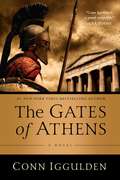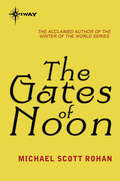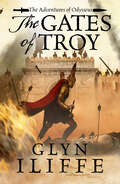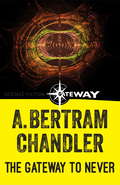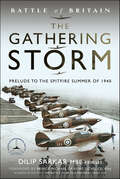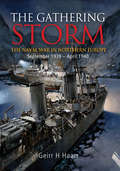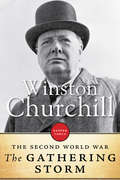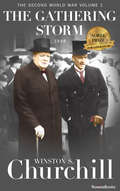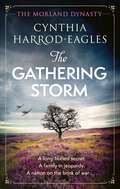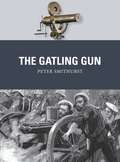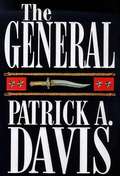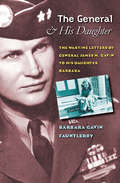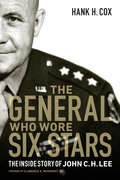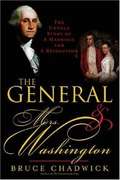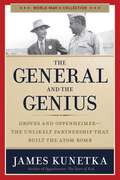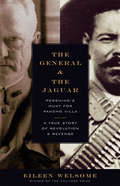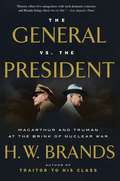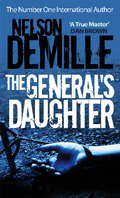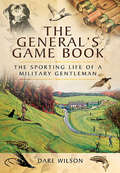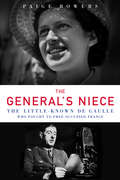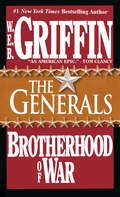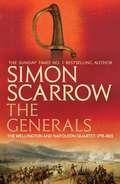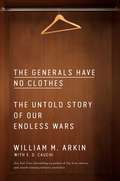- Table View
- List View
The Gates of Athens: If You Want Freedom Prepare For War
by Conn IgguldenEvoking two of the most famous battles of the Ancient World—the Battle of Marathon and the Last Stand at Thermopylae—The Gates of Athens is a bravura piece of storytelling by a well acclaimed master of the historical adventure novel.In the new epic historical novel by New York Times bestselling author Conn Iggulden, in ancient Greece an army of slaves gathers on the plains of Marathon . . . Under Darius the Great, King of Kings, the mighty Persian army—swollen by 10,000 warriors known as The Immortals—have come to subjugate the Greeks. In their path, vastly outnumbered, stands an army of freeborn Athenians. Among them is a clever, fearsome, and cunning soldier-statesman, Xanthippus. Against all odds, the Athenians emerge victorious. Yet people soon forget that freedom is bought with blood. Ten years later, Xanthippus watches helplessly as Athens succumbs to the bitter politics of factionalism. Traitors and exiles abound. Trust is at a low ebb when the Persians cross the Hellespont in ever greater numbers in their second attempt to raze Athens to the ground. Facing overwhelming forces by land and sea, the Athenians call on their Spartan allies for assistance—to delay the Persians at the treacherous pass of Thermopylae . . .
The Gates of Noon
by Michael Scott Rohan'East of the sun and west of the moon...'...you may find a freighter carrying ivory to Huy Braseal, mammoth tusks to Tartessos and Ashkelon, spices from Cathay to Lyonesse. Another world, of infinite strangeness and high adventure, yet never far from our own; round a corner, through a door into a harbourside inn and you may find yourself there.Steve Fisher had been there once, had sailed the cloud archipelagos on a desperate quest to Hispaniola. Or had he? The memories have faded...was it only a dream? Then, in Bangkok, as he struggles to arrange a shipment of vital supplies to the endangered paradise of Bali, Steve finds himself catapulted back into that world, through the eerie gates of the Spiral - and into terrible dangers. For our there is something that wants him stopped, at any costs.Shadows from the past, from the present - and from somewhere that is neither, where myths and legends and terrifying archetypes stalk the world. Entangles by old loves and ancient hatreds, with witches and warlocks to help him and the original Bogeyman on his trail, Steve must fight to reconcile past and present in an epic battle of wits which leads him from the sleazy sex bars of Bangkok to the mist-shrouded islands of the South Seas...
The Gates of Troy (The Adventures of Odysseus #Vol. 2)
by Glyn IliffeIn this historical adventure by the author of King of Ithaca, Odysseus and his warrior companion journey toward the dawning of the Trojan War. Settled in his small island kingdom, Odysseus wants nothing more than to rule Ithaca in peace. Meanwhile his warrior friend Eperitus, frustrated at his quiet life, dreams of glory in battle. But when Agamemnon&’s fleet appears on the horizon, Odysseus knows that war is upon him. Helen of Sparta has been abducted by a Trojan prince and the armies of Greece are gathering. As the greatest heroes flock to the crusade, only one is missing. Odysseus knows that without Achilles, the gates of Troy will never fall. He must use all his cunning to hunt him down and persuade him to join their cause . . . From the Greek islands to the fearsome walls of Troy, this is a novel of pulse-racing battle and intrigue, perfect for readers of George R.R. Martin, Conn Iggulden and Tad Williams. Praise for The Gates of Troy: &“Iliffe . . . displays his thorough knowledge of classical literature, vividly bringing to life the glories of Troy. . . . A satisfying tale of politics, romance, and war under the shadow of the Olympian gods in this comprehensive retelling of the genesis of the Trojan War.&” —Publishers Weekly
The Gateway to Never (John Grimes)
by A. Bertram ChandlerJohn Grimes is stranded on a Hell Planet! Another adventure with the pipe-smoking, action-loving spaceship commander Lieutenant John Grimes.
The Gathering Storm
by Brian KelleherAmerica's top test pilots try to sneak America's newest weapon- the F-86 Sabre Jet into the skies over Korea.
The Gathering Storm: Prelude to the Spitfire Summer of 1940 (Battle of Britain)
by Dilip SarkarDilip Sarkar has studied the Battle of Britain period for a lifetime and is renowned for his meticulous research and evidence-based approach, setting events within the broadest possible context. In doing so, he has helped enrich our appreciation and understanding of the past. In this, the first of a new seven volume series on the Battle of Britain, we have the background to the aerial conflict of the summer of 1940 revealed in great detail and told comprehensively as never before. No stone has been left unturned, no angle unexplored. This meticulous approach the research, combined with the human stories and events, many revealed for the first time, tells what Dilip calls ‘the Big Story’. The development of air power, the creation of Britain’s defenses, the German side, the Home Front and political events are all covered – and much more. After considering the background threads prior to the outbreak of war in 1939, this book then describes the developing conflict on land, sea and in the air. The German invasion of Norway, the Fall of France and the air fighting over Dunkirk are all explored, along with Hitler’s actual preferred policy towards Britain, which at first was one of blockade – not invasion. The author, with justification, questions the validity of the Battle of Britain’s official start-date being 10 July 1940, evidencing the fact that the fighting actually began eight days earlier. From that date onwards, a day-by-day, hour-by-hour, account of the fighting is provided, giving due recognition to those aircrew lost or wounded before 10 July 1940, and whose names are not, therefore, found amongst ‘The Few’. Due accord is also given to the Royal Navy, and efforts of both Bomber and Coastal commands, emphasizing just what a ‘big’ story this actually is – far from simply concerning a handful of Spitfire and Hurricane pilots. Through diligent research with crucial official primary sources and personal papers, Dilip unravels many myths, often challenging the accepted narrative. This is not, however, simply another dull record of combat losses and claims, far from it. Drawing upon unique first-hand accounts from a wide-range of combatants and eyewitnesses, along with the daily Home Intelligence Reports and the papers of politicians such as Italian Foreign Minister Count Ciano, this really is an unprecedented approach to understanding the build-up to and times of the Battle of Britain.
The Gathering Storm: The Naval War in Northern Europe September 1939 - April 1940
by Geirr H Haarr&“A top-of-the-line examination of operations in north European waters during the first eight months of [WWII] . . . by far the best work on that subject.&”—Stone & Stone The term &“the phony war&” is often applied to the first months of the Second World War, a term suggesting inaction or passivity. That may have been the perception of the war on land, but at sea it was very different. This new book is a superb survey of the fierce naval struggles, from 1939 up to the invasion of Norway in April 1940. The author begins the book with the sinking of the German fleet at Scapa Flow in 1919 and then covers the rebuilding of the Kriegsmarine and parallel developments in the Royal Navy and summarizes relevant advances in European navies. The main part of the book then describes the actions at sea starting with the fall of Poland. There is a complex, intertwined narrative that follows. The sinking of Courageous, the German mining of the British East Coast, the Northern Patrol, the sinking of Rawalpindi, small ship operations in the North Sea and German Bight, the Altmark incident are all covered. Further afield the author deals with the German surface raiders and looks at the early stages of the submarine war in the Atlantic. As with his previous books, Geirr Haarr has researched extensively in German, British, and other archives, and the work is intended to paint a balanced and detailed picture of this significant period of the war when the opposing naval forces were adapting to a form of naval warfare quite different to that experienced in WWI.
The Gathering Storm: The Second World War Volume 1 (The Second World War #1)
by Winston ChurchillThe Gathering Storm is the first volume in Winston Churchill’s The Second World War, a history of World War II from the end of the First World War to the conclusion of the second in 1945. Though Churchill wrote the history from his own perspective and held back necessary classified information, The Second World War is lauded as a fair and accurate account of war, and has remained one of the most important historical records of the military, political, and diplomatic realities in Britain at that time. Winston Churchill’s work on the six-volume series earned him the Nobel Prize for Literature in 1953.HarperTorch brings great works of non-fiction and the dramatic arts to life in digital format, upholding the highest standards in ebook production and celebrating reading in all its forms. Look for more titles in the HarperTorch collection to build your digital library.
The Gathering Storm: The Second World War, Volume 1 (Winston S. Churchill The Second World Wa #1)
by Winston S. Churchill&“It is our immense good fortune that a man who presided over this crisis in history is able to turn the action he lived through into enduring literature.&” —The New York Times This book is the first in Winston Churchill&’s monumental six-volume account of the struggle between the Allied Powers in Europe against Germany and the Axis during World War II. Told from the unique viewpoint of a British prime minister, it is also the story of one nation&’s heroic role in the fight against tyranny. Having learned a lesson at Munich they would never forget, the British refused to make peace with Hitler, defying him even after France had fallen and it seemed as though the Nazis were unstoppable. What lends this work its tension and power is Churchill&’s inclusion of primary source material. We are presented with not only Churchill&’s retrospective analysis of the war, but also memos, letters, orders, speeches, and telegrams, day-by-day accounts of reactions as the drama intensifies. We listen as strategies and counterstrategies unfold in response to Hitler&’s conquest of Europe, planned invasion of England, and assault on Russia. Together they give a mesmerizing account of the crucial decisions made as the fate of the world hangs in the balance. The Gathering Storm covers the Treaty of Versailles, the rise of Adolf Hitler, the capitulation of Munich, and the entry of Britain into the war. This book makes clear Churchill&’s feeling that the Second World War was a largely senseless but unavoidable conflict—and shows why Churchill earned the Nobel Prize in Literature in 1953, in part because of this awe-inspiring work.
The Gathering Storm: the brand-new Morland Dynasty novel in the beloved historical series (Morland Dynasty #36)
by Cynthia Harrod-EaglesThe eagerly-awaited return to the acclaimed Morland Dynasty series, and the 100th novel by Cynthia Harrod-EaglesEngland, 1936The reign of Edward VIII has begun, but danger for the monarchy already looms on the horizon. At home in Morland Place, Polly Morland feels alone and abandoned, with her brother summoned to France by his old employer. James soon finds himself travelling to Russia, whereas Polly will voyage on the Queen Mary with New York - and a long-lost love - her destination. Soon the family are scattered to the four winds, from Hollywood to war-torn Spain. Working for the Air Ministry on new fighter planes, Jack fears that his children are not taking the increasingly tense situation in Europe seriously enough. The nation is divided over which is the greater thread: Communist Russia, or Fascist Germany. As the storms of war gather, they will threaten to overwhelm the Morlands and destroy all that they have worked for...The BRAND-NEW novel in the acclaimed Morland Dynasty historical fiction series with over a quarter of a million copies sold. The perfect read for fans of Downton Abbey, Lucinda Riley and The Crown
The Gathering Storm: the brand-new Morland Dynasty novel in the beloved historical series (Morland Dynasty #36)
by Cynthia Harrod-EaglesThe eagerly-awaited return to the acclaimed Morland Dynasty series, and the 100th novel by Cynthia Harrod-EaglesEngland, 1936The reign of Edward VIII has begun, but danger for the monarchy already looms on the horizon. At home in Morland Place, Polly Morland feels alone and abandoned, with her brother summoned to France by his old employer. James soon finds himself travelling to Russia, whereas Polly will voyage on the Queen Mary with New York - and a long-lost love - her destination. Soon the family are scattered to the four winds, from Hollywood to war-torn Spain. Working for the Air Ministry on new fighter planes, Jack fears that his children are not taking the increasingly tense situation in Europe seriously enough. The nation is divided over which is the greater thread: Communist Russia, or Fascist Germany. As the storms of war gather, they will threaten to overwhelm the Morlands and destroy all that they have worked for...The BRAND-NEW novel in the acclaimed Morland Dynasty historical fiction series with over a quarter of a million copies sold. The perfect read for fans of Downton Abbey, Lucinda Riley and The Crown
The Gatling Gun
by Johnny Shumate Peter SmithurstA unique chapter in the history of firearms, the multibarrel, hand-cranked Gatling gun was one of the first practical rapid-fire weapons ever to be used in battle. It changed warfare by introducing the capability to project deadly, high-intensity fire on the battlefield, and portended the devastation that automatic weapons would wreak in World War I. During its 40-year career, it saw widespread service with US, British, and other forces on a host of battlefields through conflicts in Zululand and the American West, to the Spanish-American War. Although it saw widespread use in the hands of industrialized nations against various groups of indigenous native warriors, it was famously left behind by Custer at the Battle of Little Bighorn, where some argue it could have made all the difference. Featuring full-color artwork plus contemporary and close-up photographs, this engaging study investigates the origins, development, combat use, and lasting influence of the formidable Gatling gun.
The General
by Patrick A. DavisAir Force General Watkins, a member of the Joint Chiefs of Staff, has been found dead--by a gruesome, tortune-style execution not seen since its use by the Vietcong over twenty years ago. Assigned investigator Lieutenant Colonel Charlie Jensen discovers that this murder is only one link in a chain of hiddeous crimes, beginning with closely guarded secrets of the Vietnam War and extending to the hightres levels of the U.S. government.
The General & His Daughter: The Wartime Letters of General James M. Gavin to his Daughter Barbara (World War Ii: The Global, Human, And Ethical Dimension Ser.)
by Barbara Gavin FauntleroyThe fascinating personal correspondence from a commanding general of the eighty-second Airborne Division to his young daughter during World War II. James Maurice Gavin left for war in April 1943 as a colonel commanding the 505th Parachute Infantry Regiment of the eighty-second Airborne Division—America&’s first airborne division and the first to fight in World War II. In 1944, at age thirty-seven, &“Slim Jim&” Gavin, as he was known to his troops, became the eighty-second&’s commanding general—the youngest Army officer to become a major general since the Civil War. At war&’s end, this soldier&’s soldier had become one of our greatest generals—and the eighty-second&’s most decorated officer. In this book, James Gavin&’s letters home to his nine-year-old daughter, Barbara, provide a revealing portrait of the American experience in World War II through the eyes of one of its most dynamic officers. Written from ship decks, foxholes, and field tents—often just before or after a dangerous jump—they capture the day-to-day realities of combat and Gavin&’s personal reactions to the war he helped to win. With more than 200 letters spanning from Fort Bragg in 1943 to New York&’s victory parade, this collection provides an invaluable self-portrait of a great general, and a great American, in war and peace. Includes a prologue and epilogue by Barbara Gavin Fauntleroy; a foreword by Rufus Broadaway; commentary and notes by Starlyn Jorgensen; and an introduction by Gerard M. Devlin.
The General Who Wore Six Stars: The Inside Story of John C. H. Lee
by Hank H. Cox Clarence E. McKnight Jr.Lt. Gen. John C. H. Lee wore six stars on his helmet, three in front and three in back—an unusual affectation. He was a stickler for discipline and a legendary military figure whom servicemen and historians loved to hate. Yet Lee was an intensely religious person and an advocate of opportunity for African Americans in the era of Jim Crow, setting him apart from the conservative officer corps at this time. Lee was also responsible for supplying the Allied armies in Europe during World War II from D-Day through Germany’s surrender. In this long-overdue biography of the brilliant and eccentric commander, Hank H. Cox paints a vivid picture of this enormous logistical task and the man who made it all happen.The General Who Wore Six Stars delves into the perplexing details of how Lee let his idiosyncrasies get the better of him. This “pompous little son-of-a-bitch,” as some historians have called him, who was “only interested in self-advertisement,” famously moved his headquarters to Paris, where during the height of the American Army supply crisis, twenty-nine thousand of his Service of Supply troops shacked up in the finest hotels and, due to sheer numbers, created an enormous black market. Yet, Cox argues, Lee’s strategical genius throughout the war has been underappreciated not only by his contemporaries but also by World War II historians. The General Who Wore Six Stars provides a timely reassessment of this intriguing individual.
The General and Mrs. Washington: The Untold Story of a Marriage and a Revolution
by Bruce ChadwickA biography of the George and Martha Washington that establishes their place in history and captures their personalities and the deep love they had for each other. The stunning impact of their marriage on the Revolution is greater than you could have ever imagined. No biography of George Washington and his life together with his wife Martha has ever been published, and this is one of the great love stories. It tells their personal story, one often filled with tragedy. Martha had four children, George none. He became the stepfather to her offspring. Her daughter, an epileptic, died in his arms as he tried to save her. Their son Jackie, 28, a soldier, died at Yorktown from malaria. Several times in their life together, Martha saved George's life when he became mortally ill. She joined him in his winter camps to bring him comfort and grace. Every morning they would have breakfast together for one hour and the order was given that no one could interrupt them, no matter what the reason. Though the richest woman in Virginia, Martha joined her husband in his revolutionary cause. The book will also explain why these twopeople of considerable privilege committed acts of treason and rebelled against the King and England.
The General and the Genius: Groves and Oppenheimer ? The Unlikely Partnership that Built the Atom Bomb
by James KunetkaTwo ambitious men. One historic mission. With a blinding flash in the New Mexico desert in the summer of 1945, the world was changed forever. The bomb that ushered in the atomic age was the product of one of history's most improbable partnerships. The General and the Genius reveals how two extraordinary men pulled off the greatest scientific feat of the twentieth century. Leslie Richard Groves of the Army Corps of Engineers, who had made his name by building the Pentagon in record time and under budget, was made overlord of the impossibly vast scientific enterprise known as the Manhattan Project. His mission: to beat the Nazis to the atomic bomb. So he turned to the nation's preeminent theoretical physicist, J. Robert Oppenheimer--the chain-smoking, martini-quaffing son of wealthy Jewish immigrants, whose background was riddled with communist associations--Groves's opposite in nearly every respect. In their three-year collaboration, the iron-willed general and the visionary scientist led a brilliant team in a secret mountaintop lab and built the fearsome weapons that ended the war but introduced the human race to unimaginable new terrors. And at the heart of this most momentous work of World War II is the story of two extraordinary men--the general and the genius.
The General and the Jaguar: A True Story of Revolution and Revenge
by Eileen WelsomeOn the cold, dark night of March 9, 1916, Mexican revolutionary Pancho Villa--el jaguar--and his band of marauders crossed the border and raided the tiny town of Columbus, New Mexico. It was a vicious surprise attack, ending with corpses piled in the streets and psychological wounds that would last a lifetime. Suspects were rounded up, trials were held, and a virulent backlash against persons of Mexican origin erupted. General John "Black Jack" Pershing was told to assemble a small army, head into Mexico, and get Villa, dead or alive. The last hurrah for the U.S. cavalry, the "Punitive Expedition" marked America's first use of armored tanks, airplanes, and trucks against an enemy. One of the deputies Pershing would choose was a recent West Point graduate named George Patton. The expedition brought the United States and Mexico to the brink of war, but it also restored greatness to both prey and predator. More than a classic account of the war for control of the West, The General and the Jaguar is a brilliant chronicle of obsession and revenge and a dual portrait of Pershing and Pancho Villa, two of the greatest military minds of all time.
The General vs. the President: MacArthur and Truman at the Brink of Nuclear War
by H. W. BrandsFrom master storyteller and historian H. W. Brands comes the riveting story of how President Harry Truman and General Douglas MacArthur squared off to decide America's future in the aftermath of World War II. At the height of the Korean War, President Harry S. Truman committed a gaffe that sent shock waves around the world. When asked by a reporter about the possible use of atomic weapons in response to China's entry into the war, Truman replied testily, "The military commander in the field will have charge of the use of the weapons, as he always has." This suggested that General Douglas MacArthur, the willful, fearless, and highly decorated commander of the American and U.N. forces, had his finger on the nuclear trigger. A correction quickly followed, but the damage was done; two visions for America's path forward were clearly in opposition, and one man would have to make way. Truman was one of the most unpopular presidents in American history. Heir to a struggling economy, a ruined Europe, and increasing tension with the Soviet Union, on no issue was the path ahead clear and easy. General MacArthur, by contrast, was incredibly popular, as untouchable as any officer has ever been in America. The lessons he drew from World War II were absolute: appeasement leads to disaster and a showdown with the communists was inevitable--the sooner the better. In the nuclear era, when the Soviets, too, had the bomb, the specter of a catastrophic third World War lurked menacingly close on the horizon. The contest of wills between these two titanic characters unfolds against the turbulent backdrop of a faraway war and terrors conjured at home by Joseph McCarthy. From the drama of Stalin's blockade of West Berlin to the daring landing of MacArthur's forces at Inchon to the shocking entrance of China into the war, The General and the President vividly evokes the making of a new American era.From the Hardcover edition.
The General's Daughter (Paul Brenner)
by Nelson DeMilleHer murder was just the beginning. She was an army captain and the daughter of legendary General 'Fighting Joe' Campbell, when her body was found - naked and bound - on the firing range of Fort Hadley. This political powder keg of a case goes directly to elite army investigator Paul Brenner and rape specialist Cynthia Sunhill - and explodes.Behind the military code of honour, Brenner and Sunhill uncover trails of corruption - all leading to the golden girl's shocking secret life.
The General's Game Book: The Sporting Life of a Military Gentleman
by Major General Dare WilsonDare Wilson's sporting career dates back to 1920s when, as a small boy, he started fishing in Northumberland on River Derwent. Since then as he has pursued successful careers in the Army and Conservation, he has fished and shot all over the world; turkey hunting and snake catching in Georgia, pheasants in Korea, sand grouse and quail in Palestine, geese in Ireland, ducks in Manitoba.A natural story teller, General Wilson's sporting career almost ended while wildfowling in The Wash in early 1939 he, his Cambridge University friends and their dogs were saved by a miracle. An uninterrupted line of black Labradors have shared Dare's experiences. The current one, is the 12th. For good measure the General tells of his thrilling winter sports (skiing and cresta) and parachuting experiences. His team of SAS free-fallers broke the World Record in 1962 tragically one member died.Dare may have lived life on the edge but the risks he has taken have always been carefully calculated. Had they not been he would not still be an active fisherman and shot in his 90's. This is a treasure trove of sporting stories.
The General's Niece: The Little-Known de Gaulle Who Fought to Free Occupied France
by Paige Bowers"My dear Uncle Charles," twenty-two-year-old Geneviève de Gaulle wrote on May 6, 1943. "Maybe you have already heard about the different events affecting the family." The general's brother Pierre had been taken by the Gestapo; his brother Xavier, Geneviève's father, had escaped to Switzerland. Geneviève asked her uncle where she could be most useful—France? England? A French territory? When no response came immediately, she decided to stay in France to help carry out his call to resist the Nazis.Based on interviews with family members, former associates, prominent historians, and never-before-seen papers written by Geneviève de Gaulle, The General's Niece is the first English-language biography of Charles de Gaulle's niece, confidante, and daughter figure, Geneviève, to whom the legendary French general and president dedicated his war memoirs.Journalist Paige Bowers leads readers through the remarkable life of this young woman who risked death to become one of the most devoted foot soldiers of the French resistance. Beginning with small acts of defiance such as tearing down swastikas and pro-Vichy posters, she eventually ferried arms and false letters of transit to fellow résistants and edited and distributed the nation's largest underground newspaper, until she was arrested and sent to the infamous Ravensbrück concentration camp. The General's Niece reveals the horrors the young de Gaulle witnessed and endured there that could have broken her spirit but instead inspired her many remaining years of activism on behalf of former prisoners and of France's neediest citizens.Finally emerging from the shadow of her famous uncle, the life of this little-known de Gaulle adds a fascinating layer to the history of the second world war, including the French resistance, the horrors of and unshakeable bonds formed at Ravensbrück, and the issues facing postwar France and its leaders.
The Generals (Brotherhood of War #6)
by W.E.B. GriffinThey were the leaders, the men who made the decisions that changed the outcome of battles...and the fate of continents. From the awesome landing at Normandy to the tortorous campaigns of the South Pacific, from the frozen hills of Korea to the devastated wastes of Dien Bien Phu, they had earned their stars. Now they led America's finest against her most relentless enemy deep in the jungles of Southeast Asia. It was a new kind of war, but the Generals led a new kind of army, ready for battle--and for glory...
The Generals (Wellington and Napoleon 2)
by Simon ScarrowTHE GENERALS is the compelling second novel in Simon Scarrow's bestselling Wellington and Napoleon quartet. A must read for fans of Bernard Cornwell.In the turbulent aftermath of the French Revolution Napoleon Bonaparte stands accused of treachery and corruption. His reputation is saved by his skill in leading his men to victory in Italy and Egypt. But then he must restore order in France and find peace or victory over her enemies: England - and Arthur Wellesley (the future Duke of Wellington).Wellesley is leading a vast army in India, where British interests are under threat. The campaign will result in the creation of the Raj - the jewel in the British Empire's crown. Wellesley returns to England a hardened veteran and more determined than ever to end France's domination of Europe.Both Wellesley and Napoleon intend to win - whatever the cost. Who will ultimately succeed?
The Generals Have No Clothes: The Untold Story of Our Endless Wars
by William M. ArkinThe definitive book about America&’s perpetual wars and how to end them from bestselling author, military expert, and award-winning journalist William M. Arkin.The first rule of perpetual war is to never stop, a fact which former NBC News analyst William M. Arkin knows better than anyone, having served in the Army and having covered all of America&’s wars over the past three decades. He has spent his career investigating how the military throws around the word &“war&” to justify everything, from physical combat to today&’s globe-straddling cyber and intelligence network. In The Generals Have No Clothes, Arkin traces how we got where we are—bombing ten countries, killing terrorists in dozens more—all without Congressional approval or public knowledge. Starting after the 9/11 attacks, the government put forth a singular idea that perpetual war was the only way to keep the American people safe. Arkin explains why President Obama failed to achieve his national security goal of ending war in Iraq and reducing our military engagements, and shows how President Trump has been frustrated in his attempts to end conflict in Afghanistan and Syria. He also reveals how COVID-19 is a watershed moment for the military, where the country&’s civilian and public health needs clash with the demands of future wars against China and Russia, North Korea and Iran. Proposing bold solutions, Arkin calls for a new era of civilian control over the military. He also calls for a Global Security Index (GSX), the security equivalent to the Dow Jones Industrial Average, which would measure the national and international events in real time to determine whether perpetual war is actually making the nation safer. Arguing that the American people should be empowered by facts rather than spurred by fear, The Generals Have No Clothes outlines how we can take control of the military…before it&’s too late.
